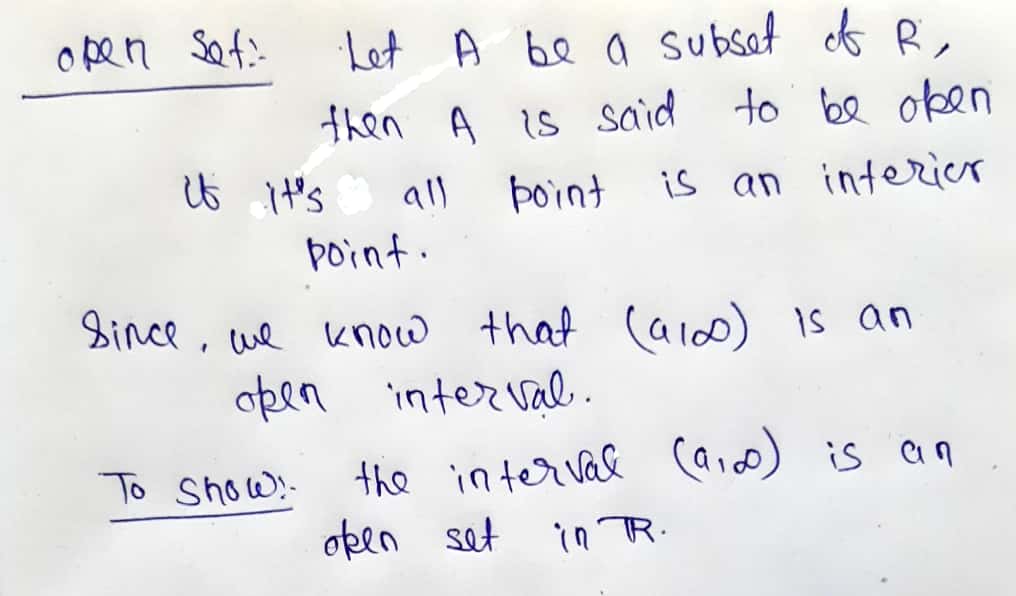
Advanced Engineering Mathematics
10th Edition
ISBN: 9780470458365
Author: Erwin Kreyszig
Publisher: Wiley, John & Sons, Incorporated
expand_more
expand_more
format_list_bulleted
Question

Transcribed Image Text:**Title: Proving the Openness of the Interval \(E = (a, +\infty)\) in \(\mathbb{R}\)**
**Objective:**
To prove that the interval \(E = (a, +\infty)\) is an open set in the real number system \(\mathbb{R}\). We will show all the details of the proof.
**Introduction to Open Sets:**
In the context of real numbers, a set \(S\) is open if, for every point \(x \in S\), there exists an \(\epsilon > 0\) such that the interval \((x - \epsilon, x + \epsilon) \subseteq S\).
**Proof:**
We need to show that for any \(x \in (a, +\infty)\), there exists an \(\epsilon > 0\) for which \((x - \epsilon, x + \epsilon) \subseteq (a, +\infty)\).
1. **Choose any \(x \in (a, +\infty)\).**
- By definition, \(x > a\).
2. **Define \(\epsilon = \frac{x - a}{2}\).**
- Since \(x > a\), \(\epsilon\) is positive.
3. **Consider the interval \((x - \epsilon, x + \epsilon)\).**
- Calculate \(x - \epsilon = x - \frac{x - a}{2} = \frac{2x - x + a}{2} = \frac{x + a}{2}\).
- Note that \(\frac{x + a}{2} > a\) because \(x > a\).
4. **Verify that \((x - \epsilon, x + \epsilon) \subseteq (a, +\infty)\):**
- From above, \(x - \epsilon = \frac{x + a}{2} > a\), ensuring \(x - \epsilon > a\).
- Therefore, the entire interval \((x - \epsilon, x + \epsilon)\) is contained within \((a, +\infty)\).
**Conclusion:**
Since for every \(x \in (a, +\infty)\), there exists an \(\epsilon > 0\) such that \((x - \epsilon, x + \epsilon
Expert Solution
arrow_forward
Step 1

Step by stepSolved in 2 steps with 2 images

Knowledge Booster
Similar questions
- Let R, S, and T be sets. Let f: R -» S, and g: S -» T be maps. Assume we know that qf is 1-1 Must f be 1-1? Either prove that it is or find a counterexample (a) Must g be 1-1? Either prove that it is or find a counterexample (b)arrow_forwardc) Let the set A = {-1,0, 1} and consider the following function: f3 A × A → A × A given by f(x,y) = (y7,x). Decide whether this function is injective, surjective, a bijection. f3 is an injection: Not Answered • ƒ3 is a surjection: Not Answered f3 is a bijection: Not Answered d) Let the set A = {1, 2, 3,4} and let P(A) denote the power-set of A. Consider the following function: f₁ : P(A) → P(A) given by ƒ(B) = {1, 2, 3}\B. Decide whether this function is injective, surjective, a bijection. f4 is an injection: Not Answered f4 is a surjection: Not Answered • f is a bijection: Not Answeredarrow_forwardHow to prove the following: if A ⊂ image f then f(f -1(A)) = A.arrow_forward
arrow_back_ios
arrow_forward_ios
Recommended textbooks for you
 Advanced Engineering MathematicsAdvanced MathISBN:9780470458365Author:Erwin KreyszigPublisher:Wiley, John & Sons, Incorporated
Advanced Engineering MathematicsAdvanced MathISBN:9780470458365Author:Erwin KreyszigPublisher:Wiley, John & Sons, Incorporated Numerical Methods for EngineersAdvanced MathISBN:9780073397924Author:Steven C. Chapra Dr., Raymond P. CanalePublisher:McGraw-Hill Education
Numerical Methods for EngineersAdvanced MathISBN:9780073397924Author:Steven C. Chapra Dr., Raymond P. CanalePublisher:McGraw-Hill Education Introductory Mathematics for Engineering Applicat...Advanced MathISBN:9781118141809Author:Nathan KlingbeilPublisher:WILEY
Introductory Mathematics for Engineering Applicat...Advanced MathISBN:9781118141809Author:Nathan KlingbeilPublisher:WILEY Mathematics For Machine TechnologyAdvanced MathISBN:9781337798310Author:Peterson, John.Publisher:Cengage Learning,
Mathematics For Machine TechnologyAdvanced MathISBN:9781337798310Author:Peterson, John.Publisher:Cengage Learning,


Advanced Engineering Mathematics
Advanced Math
ISBN:9780470458365
Author:Erwin Kreyszig
Publisher:Wiley, John & Sons, Incorporated

Numerical Methods for Engineers
Advanced Math
ISBN:9780073397924
Author:Steven C. Chapra Dr., Raymond P. Canale
Publisher:McGraw-Hill Education

Introductory Mathematics for Engineering Applicat...
Advanced Math
ISBN:9781118141809
Author:Nathan Klingbeil
Publisher:WILEY

Mathematics For Machine Technology
Advanced Math
ISBN:9781337798310
Author:Peterson, John.
Publisher:Cengage Learning,

